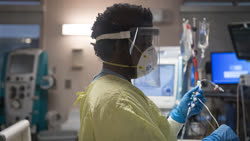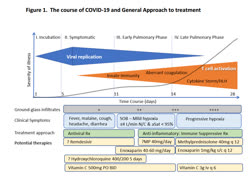|
Hospitals using IV-C |
|
Why this 1944 protocol took until 2020 to gain acceptance This was not medicines proudest moment. |
|
Newly discovered beneficial outcomes after high doses of vitamin C therapy in clinical trials have elevated the nutrient's status as a leading therapeutic option for COVID-19.
Role of vitamin C in preventing of COVID-19 infection, progression and severity |
|
"Other adjunctive interventions with biologic plausibility include Vitamin C" Determine interventions that improve the clinical outcome of COVID-19
infected patients |
|
"Vitamin C is administered at a dose of 50 to 100 mg / kg per day, and the continuous use time is aimed at a significant improvement in the oxygenation index. To stop cytokine storms large doses of vitamin C are administered intravenously at a dose of 100 to 200 mg / kg daily." Shanghai Expert Group on Clinical Treatment of New Coronavirus Diseases. Expert Consensus on Comprehensive Treatment of Coronavirus Diseases in Shanghai in 2019 [J / OL].
Chinese Journal of Infectious Diseases, 2020,38 (2020-03-01).
|
|
This was a game changer in our hospital" Why an inexpensive anti-inflammatory drug used to treat severe respiratory failure and shown to decrease mortality and dependence on a ventilator goes unused in COVID-19 patients |
|
The Lancet - "Rescue therapy with high-dose vitamin C can also be considered" Treatment for severe acute respiratory distress syndrome from COVID-19 |
|
COVID-19, ARDS & cell free hemoglobin - the ascorbic acid connection Cell-Free Hemoglobin – The Cause of Acute Respiratory Distress Syndrome in COVID-19 |
|
How to protect yourself from the coronavirus pandemic - by Alyse M. Hamilton, MD
Did you know that the coronavirus (COVID-19) pandemic can be dramatically slowed, and possibly even stopped, with the immediate widespread use of very high doses of vitamin C?
|
|
Can early and high intravenous dose of vitamin C prevent and treat coronavirus disease 2019 (COVID-19)? The COVID-19 (SARS-2-Cov) pandemic, first reported in Wuhan, China, is now spreading to many continents and countries, causing a severe public health burden. Currently, there is no vaccine or specific antiviral drug for this deadly disease. A quick, deployable and accessible, effective and safe treatment is urgently needed to save lives and curtail the spreading. Acute respiratory distress syndrome (ARDS) is a key factor of fatality. Significantly increased oxidative stress due to rapid release of free radicals and cytokines is the hallmark of ARDS which leads to cellular injury, organ failure and death. Early use of large dose antioxidants, such as vitamin C (VC) may become an effective treatment for these patients. Clinical studies also show that high-dose oral VC provides certain protection against viral infection. Neither intravenous nor oral administration of high-dose VC is associated with significant side effects. Therefore, this regimen should be included in the treatment of COVID-19 and used as a preventative measure for susceptible populations such as healthcare workers with higher exposure risks. |
|
Intravenous vitamin C for reduction of cytokines storm in acute respiratory distress syndrome
The recent outbreak of Covid19 has required urgent treatments for numerous patients. No suitable vaccines or antivirals are available for Covid19. The efficiency against Covid19 of WHO therapies of choice, that are two antivirals developed for other pathologies, is controversial. Therefore, alternative approaches are required. Intravenous (IV) Vitamin C (Vit-C) has emerged as one of the other alternatives for this purpose. Here we review the effects of IV Vit-C on the immune system response, the antiviral properties of IV Vit-C, and finally the antioxidant properties of IV Vit-C to specifically address the cytokines' storm characteristic of the Acute Respiratory Distress Syndrome (ARDS) that occur in the later cycle of the Covid19 infectious disease. |
|
"a significant mortality benefit" or How to lie with statistics to prove C doesn't work. " explains the methodology
and reporting of the CITRIS-ALI study. As reported in the study,
the primary endpoint (change in SOFA score) was negative, yet
there was a significant mortality benefit. While appearing difficult
to reconcile these opposing findings, logical explanations exist"
|
|
Could vitamin C save lives in sepsis? These hospitals aren’t waiting for proof.
|
|
Vitamin C for the treatment of sepsis: The scientific rationale Sepsis is associated with an acute deficiency of vitamin C. In experimental sepsis models, intravenous vitamin C reduces organ injury and improves survival. In addition, emerging evidence suggests that the combination of vitamin C, corticosteroids and thiamine may act synergistically to reverse sepsis induced organ dysfunction.
|
|
Vitamin C and Infections In the early literature, vitamin C deficiency was associated with pneumonia. After its identification, a number of studies investigated the effects of vitamin C on diverse infections. A total of 148 animal studies indicated that vitamin C may alleviate or prevent infections caused by bacteria, viruses, and protozoa. The most extensively studied human infection is the common cold. Vitamin C administration does not decrease the average incidence of colds in the general population, yet it halved the number of colds in physically active people. Regularly administered vitamin C has shortened the duration of colds, indicating a biological effect. However, the role of vitamin C in common cold treatment is unclear. Two controlled trials found a statistically significant dose–response, for the duration of common cold symptoms, with up to 6–8 g/day of vitamin C. Thus, the negative findings of some therapeutic common cold studies might be explained by the low doses of 3–4 g/day of vitamin C. Three controlled trials found that vitamin C prevented pneumonia. Two controlled trials found a treatment benefit of vitamin C for pneumonia patients. One controlled trial reported treatment benefits for tetanus patients. The effects of vitamin C against infections should be investigated further |
|
Intravenous vitamin C as adjunctive therapy for enterovirus/rhinovirus induced acute respiratory distress syndrome We report a case of virus-induced acute respiratory distress syndrome (ARDS) treated with parenteral vitamin C in a patient testing positive for enterovirus/rhinovirus on viral screening. This report outlines the first use of high dose intravenous vitamin C as an interventional therapy for ARDS, resulting from enterovirus/rhinovirus respiratory infection. From very significant preclinical research performed at Virginia Commonwealth University with vitamin C and with the very positive results of a previously performed phase I safety trial infusing high dose vitamin C intravenously into patients with severe sepsis, we reasoned that infusing identical dosing to a patient with ARDS from viral infection would be therapeutic. We report here the case of a 20-year-old, previously healthy, female who contracted respiratory enterovirus/rhinovirus infection that led to acute lung injury and rapidly to ARDS. She contracted the infection in central Italy while on an 8-d spring break from college. During a return flight to the United States, she developed increasing dyspnea and hypoxemia that rapidly developed into acute lung injury that led to ARDS. When support with mechanical ventilation failed, extracorporeal membrane oxygenation (ECMO) was initiated. Twelve hours following ECMO initiation, high dose intravenous vitamin C was begun. The patient’s recovery was rapid. ECMO and mechanical ventilation were discontinued by day-7 and the patient recovered with no long-term ARDS sequelae. Infusing high dose intravenous vitamin C into this patient with virus-induced ARDS was associated with rapid resolution of lung injury with no evidence of post-ARDS fibroproliferative sequelae. Intravenous vitamin C as a treatment for ARDS may open a new era of therapy for ARDS from many causes. |
|
I take 1,000 milligrams a day. - Dr. Anthony Fauci, US Surgeon General, 2016
How to Avoid Getting Sick When You’re Around People All Day |
|
Intravenous Vitamin C Administered as Adjunctive Therapy for Recurrent Acute Respiratory Distress Syndrome This case report summarizes the first use of intravenous vitamin C employed as an adjunctive interventional agent in the therapy of recurrent acute respiratory distress syndrome (ARDS). The two episodes of ARDS occurred in a young female patient with Cronkhite-Canada syndrome, a rare, sporadically occurring, noninherited disorder that is characterized by extensive gastrointestinal polyposis and malabsorption. Prior to the episodes of sepsis, the patient was receiving nutrition via chronic hyperalimentation administered through a long-standing central venous catheter. The patient became recurrently septic with Gram positive cocci which led to two instances of ARDS. This report describes the broad-based general critical care of a septic patient with acute respiratory failure that includes fluid resuscitation, broad-spectrum antibiotics, and vasopressor support. Intravenous vitamin C infused at 50 mg per kilogram body weight every 6 hours for 96 hours was incorporated as an adjunctive agent in the care of this patient. Vitamin C when used as a parenteral agent in high doses acts “pleiotropically” to attenuate proinflammatory mediator expression, to improve alveolar fluid clearance, and to act as an antioxidant. |
|
Vitamin C Is an Essential Factor on the Anti-viral Immune Responses through the Production of Interferon-α/β at the Initial Stage of Influenza A Virus (H3N2) Infection L-ascorbic acid (vitamin C) is one of the well-known anti-viral agents, especially to influenza virus. Since the in vivo anti-viral effect is still controversial, we investigated whether vitamin C could regulate influenza virus infection in vivo by using Gulo (-/-) mice, which cannot synthesize vitamin C like humans. First, we found that vitamin C-insufficient Gulo (-/-) mice expired within 1 week after intranasal inoculation of influenza virus (H3N2/Hongkong). Viral titers in the lung of vitamin C-insufficient Gulo (-/-) mice were definitely increased but production of anti-viral cytokine, interferon (IFN)-α/β, was decreased. On the contrary, the infiltration of inflammatory cells into the lung and production of pro-inflammatory cytokines, tumor necrosis factor (TNF)-α and interleukin (IL)-α/β, were increased in the lung. Taken together, vitamin C shows in vivo anti-viral immune responses at the early time of infection, especially against influenza virus, through increased production of IFN-α/β. |
|
"...vitamin C kills influenza virus..." n vitro experiments showed that pharmacological ascorbate killed not only isolated viruses, but also viruses from normal human bronchial epithelial cells. The antiviral effect of ascorbic acid appeared to be dose-dependent. 2.5 mmol/L ascorbic acid was able to eliminate 90% of the viruses and 20 mmol/L ascorbic acid totally blocked viral replication in vitro. The antiviral effect of pharmacological ascorbate varied at different phases of infection. Pharmacological ascorbate eliminated viral infectivity with treatment times as short as 4 hours at early stage of infection. But the effect was reversed by catalase. |
|
Mechanisms of attenuation of abdominal sepsis induced acute lung injury by ascorbic acid We recently showed that vitamin C, administered after the onset of endotoxemia, attenuates proinflammatory and procoagulant states that induce lung vascular injury and improved survival in an animal model of sepsis (23). In the present study we show that vitamin C attenuates sepsis-induced ALI by enhancing alveolar epithelial barrier integrity. Furthermore, vitamin C induced the expression of ion channels and pumps, which play critical roles in improving alveolar fluid clearance. In addition, we also observed marked changes in the viscoelastic clot properties of septic mice blood. Vitamin C infusion completely normalized the coagulopathy in septic mice. |
|
Vitamin C for Intravenous Use Soon after its discovery and synthesis in 1932, parenteral vitamin C was shown to significantly decrease polio virus infections in primates [31], [32]. |
|
Linus Pauling was right all along. A doctor's opinion "Pauling had performed a series of trials with Dr Ewan Cameron, a Scottish cancer specialist, showing that intravenous vitamin C allowed cancer patients to live much longer than expected. Numerous other studies confirmed this effect, particularly the work of Dr Abram Hoffer and Dr Hugh Riordan. The Mayo Clinic tried to refute this research but failed, as they used low, oral doses, making their results invalid. In their own cancer paper, the NIH researchers claimed that Pauling and Cameron's use of the IV route was "serendipitous", implying that Pauling did not know the difference between injected and oral doses. In fact, Pauling had written explicitly about this difference, so the NIH criticism was misplaced." |
|
45 to 91% reduction in common cold and 80 to 100% reduction in the incidence of pneumonia in the vitamin C group Vitamin C Supplementation and Respiratory Infections: a Systematic Review
|
|
"most viral diseases could be cured by intravenous sodium ascorbate" "Based on my experience with over 11,000 patients
during the past 14 years, it has been my consistent
observation that the amount of ascorbic acid dissolved
in water which a patient, tolerant to ascorbic acid,
can ingest orally without producing diarrhea, increases
considerably somewhat proportionately with the ‘toxicity’
of his illness. A person who can tolerate orally 10
to 1.5 grams of ascorbic acid per 24 hours when well,
might be able to tolerate 30 to 60 grams per 24 hours
if lhe has a mild cold, 100 grams with a severe cold,
15lD grams with influenza, and 200 grams per 24 hours
with mononucleosis or viral pneumonia. The clinical
symtpoms of these diseases and other conditions previously
described, are markedly ameliorated only as
bnwef tolerance dose levels (the amount that almost,
but not quite, causes diarrhea) are approached (20, 21,
22, 23, 24, 25)"
|
|
"Klenner's paper on curing 60 cases of polio in the epidemic of 1948 should have changed the way infectious diseases were treated but it did not." "Klenner's paper (Klenner FR. The treatment of poliomyelitis and other virus diseases with vitamin C. J. South. Med. and Surg., 111:210-214, 1949.) on curing 60 cases of polio in the epidemic of 1948 should have changed the way infectious diseases were treated but it did not." - Robert Cathcart
|




